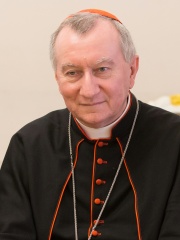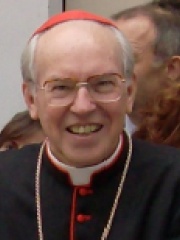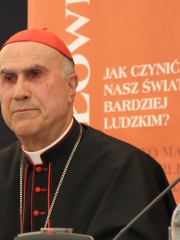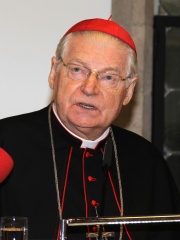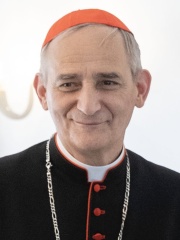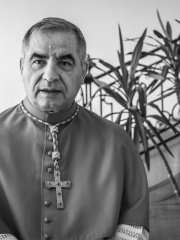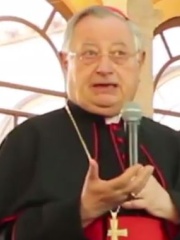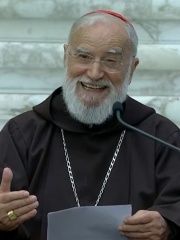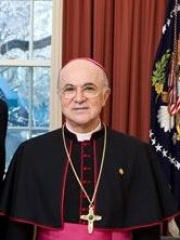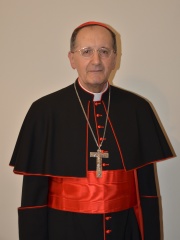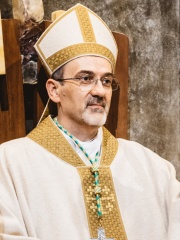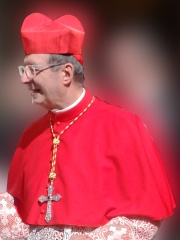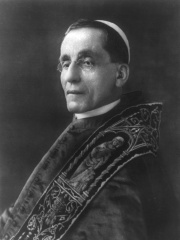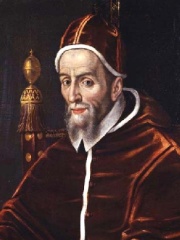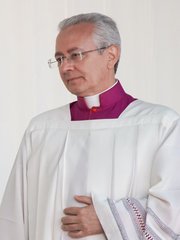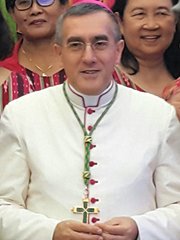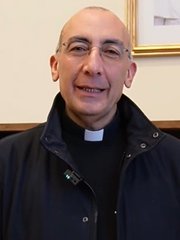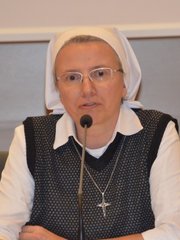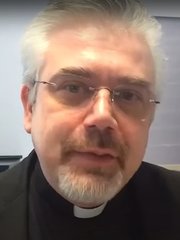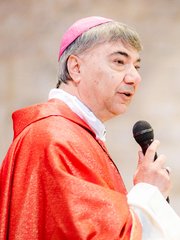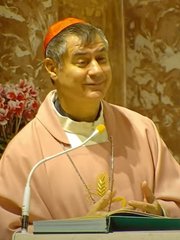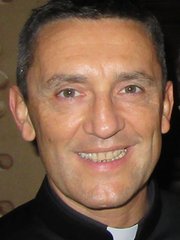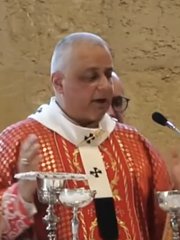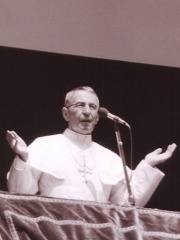
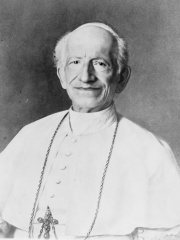
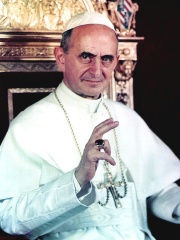
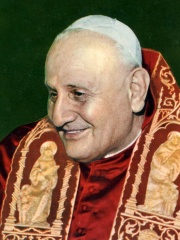
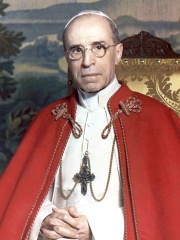
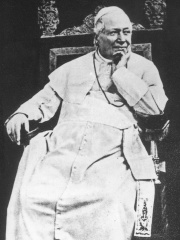
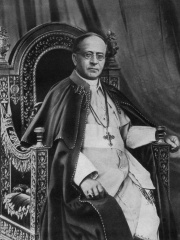
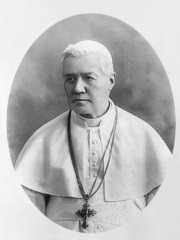
The Most Famous
RELIGIOUS FIGURES from Italy
This page contains a list of the greatest Italian Religious Figures. The pantheon dataset contains 3,187 Religious Figures, 569 of which were born in Italy. This makes Italy the birth place of the most number of Religious Figures.
Top 10
The following people are considered by Pantheon to be the top 10 most legendary Italian Religious Figures of all time. This list of famous Italian Religious Figures is sorted by HPI (Historical Popularity Index), a metric that aggregates information on a biography's online popularity. Visit the rankings page to view the entire list of Italian Religious Figures.

1. Pope John Paul I (1912 - 1978)
With an HPI of 89.80, Pope John Paul I is the most famous Italian Religious Figure. His biography has been translated into 110 different languages on wikipedia.
Pope John Paul I (born Albino Luciani; 17 October 1912 – 28 September 1978) was head of the Catholic Church and sovereign of Vatican City from 26 August 1978 until his death 33 days later. His reign is among the shortest in papal history, giving rise to the most recent year of three popes—the first since 1605. John Paul I remains the most recent Italian-born pope, the last in a succession of such popes that started with Clement VII in 1523. He was also the first pope to have been born in the 20th century. Before the August 1978 papal conclave that elected him, he expressed his desire not to be elected, telling those close to him that he would decline the papacy if elected, but despite this, upon the cardinals' electing him, he felt an obligation to accept. He was the first pontiff to have a double name, choosing "John Paul" in honour of his two immediate predecessors, John XXIII and Paul VI. He explained that he was indebted to John XXIII and to Paul VI for naming him a bishop and a cardinal, respectively. Furthermore, he was the only pope to add the ordinal number "I" to his papal name when choosing it. It was reported by Catholic media that John Paul was not aware at the time that this was unusual. His two immediate successors, John Paul II and Benedict XVI, later recalled the warm qualities of the late pontiff in several addresses. In Italy, he is remembered with the appellatives of Il Papa del sorriso (transl. "The Pope of the smile") and Il sorriso di Dio (transl. "The smile of God"). Time magazine and other publications referred to him as "The September Pope". He is also referred to in Italy as "Papa Luciani" to distinguish him from his successor of the same papal name. In his hometown of Canale d'Agordo a museum built and named in his honour is dedicated to his life and brief papacy. John Paul I was declared a Servant of God by his successor, John Paul II, on 23 November 2003. Pope Francis confirmed John Paul's heroic virtue on 8 November 2017 and titled him as venerable. Francis presided over John Paul's beatification on 4 September 2022.

2. Pope Leo XIII (1810 - 1903)
With an HPI of 88.51, Pope Leo XIII is the 2nd most famous Italian Religious Figure. His biography has been translated into 92 different languages.
Pope Leo XIII (Italian: Leone XIII; born Gioacchino Vincenzo Raffaele Luigi Pecci; 2 March 1810 – 20 July 1903) was head of the Catholic Church from 1878 until his death in 1903. He had the fourth-longest reign of any pope, behind those of St. Peter, Pius IX (his predecessor), and John Paul II. Born in Carpineto Romano, near Rome, Leo XIII is well known for his intellectualism and his attempts to define the position of the Catholic Church with regard to modern thinking. In his 1891 encyclical Rerum novarum, Pope Leo outlined the rights of workers to a fair wage, safe working conditions, and the formation of trade unions, while affirming the rights to property and free enterprise, opposing both atheistic socialism and laissez-faire capitalism. With that encyclical, he became popularly called the "Social Pope" and the "Pope of the Workers", also having created the foundations for modern thinking in the social doctrines of the Catholic Church, influencing his successors. He influenced the Mariology of the Catholic Church and promoted both the rosary and the scapular. Upon his election, he immediately sought to revive Thomism, the theological system of Augustine of Hippo and Thomas Aquinas, wishing to make it the official political, theological, and philosophical foundation of the Catholic Church. As a result, he sponsored the Editio Leonina in 1879. Leo XIII is remembered for his belief that pastoral activity in political sociology is also a vital mission of the church as a vehicle of social justice and maintaining the rights and dignities of the human person. He issued a record eleven papal encyclicals on the rosary, earning him the title "Rosary Pope". He also approved two new Marian scapulars. He was the first pope never to have held any control over the Papal States, which had been dissolved by 1870, since Stephen II in the 8th century. Similarly, many of his policies were oriented toward mitigating the loss of the Papal States in an attempt to overcome the loss of temporal power, but nonetheless continuing the Roman Question. After his death in 1903, he was buried in the Vatican Grottoes. In 1924, his remains were transferred to the Archbasilica of Saint John Lateran.

3. Pope Paul VI (1897 - 1978)
With an HPI of 88.00, Pope Paul VI is the 3rd most famous Italian Religious Figure. His biography has been translated into 108 different languages.
Pope Paul VI (born Giovanni Battista Enrico Antonio Maria Montini; 26 September 1897 – 6 August 1978) was head of the Catholic Church and sovereign of Vatican City from 21 June 1963 until his death on 6 August 1978. Succeeding John XXIII, he continued the Second Vatican Council, which he closed in 1965, implementing its numerous reforms. He fostered improved ecumenical relations with Eastern Orthodox and Protestant churches, which resulted in many historic meetings and agreements. In January 1964, he flew to Jordan, the first time a reigning pontiff had left Italy in more than a century. Montini served in the Holy See's Secretariat of State from 1922 to 1954, and along with Domenico Tardini was considered the closest and most influential advisor of Pope Pius XII. In 1954, Pius named Montini Archbishop of Milan, the largest Italian diocese. Montini later became the Secretary of the Italian Bishops' Conference. John XXIII elevated Montini to the College of Cardinals in 1958, and after his death, Montini was, with little to no opposition, elected his successor, taking the name Paul VI. He reconvened the Second Vatican Council, which had been suspended during the interregnum. After its conclusion, Paul VI took charge of the interpretation and implementation of its mandates, finely balancing the conflicting expectations of various Catholic groups. The resulting reforms were among the widest and deepest in the Church's history. Paul VI spoke repeatedly to Marian conventions and Mariological meetings, visited Marian shrines and issued three Marian encyclicals. Following Ambrose of Milan, he named Mary as the Mother of the Church during the Second Vatican Council. He described himself as a humble servant of a suffering humanity and demanded significant changes from the rich in North America and Europe in favour of the poor in the Third World. His opposition to birth control was published in the 1968 encyclical Humanae vitae. Pope Benedict XVI, citing his heroic virtue, proclaimed him venerable on 20 December 2012. Pope Francis beatified Paul VI on 19 October 2014, after the recognition of a miracle attributed to his intercession. His liturgical feast was celebrated on the date of his birth, 26 September, until 2019 when it was changed to the date of his priestly ordination, 29 May. Pope Francis canonised him on 14 October 2018. Paul VI is the most recent pope to take the pontifical name "Paul".

4. Pope John XXIII (1881 - 1963)
With an HPI of 87.98, Pope John XXIII is the 4th most famous Italian Religious Figure. His biography has been translated into 111 different languages.
Pope John XXIII (born Angelo Giuseppe Roncalli; 25 November 1881 – 3 June 1963) was head of the Catholic Church and sovereign of Vatican City from 28 October 1958 until his death on 3 June 1963. He is the most recent pope to take the pontifical name "John". Roncalli was among 13 children born to Marianna Mazzola and Giovanni Battista Roncalli in a family of sharecroppers who lived in Sotto il Monte, a village in the province of Bergamo, Lombardy. He was ordained to the priesthood on 10 August 1904 and served in a number of posts, as nuncio in France and a delegate to Bulgaria, Greece and Turkey. In a consistory on 12 January 1953 Pope Pius XII made Roncalli a cardinal as the Cardinal-priest of Santa Prisca in addition to naming him as the Patriarch of Venice. Roncalli was unexpectedly elected pope on 28 October 1958 at age 76 after Pope Pius XII's death. Pope John XXIII surprised those who expected him to be a caretaker pope by calling the historic Second Vatican Council (1962–1965), the first session opening on 11 October 1962, which is now his feast. John XXIII made many passionate speeches during his pontificate. His views on equality were summed up in his statement, "We were all made in God's image, and thus, we are all Godly alike." He made a major impact on the Catholic Church, opening it up to the changes of the Second Vatican Council and by his own dealings with other churches and nations. In Italian politics, he prohibited bishops from interfering with local elections, and he helped the Christian Democracy party to cooperate with the Italian Socialist Party. In international affairs, his Ostpolitik engaged in dialogue with the communist countries of Eastern Europe. He especially reached out to the Eastern Orthodox churches. His overall goal was to modernize the Church by emphasizing its pastoral role, and its necessary involvement with affairs of state. He dropped the traditional rule of 70 cardinals, increasing the size to 85. He used the opportunity to name the first cardinals from Africa, Japan, and the Philippines. He promoted ecumenical movements in cooperation with other Christian faiths. In doctrinal matters, he was a traditionalist, but he ended the practice of automatically formulating social and political policies on the basis of old theological propositions. He did not live to see the Second Vatican Council to completion. In September 1962, he was diagnosed with stomach cancer and died eight months later on 3 June 1963. His cause for canonization was opened on 18 November 1965 by his successor, Pope Paul VI, who declared him a Servant of God. He was beatified by Pope John Paul II in 2000. On 5 July 2013, Pope Francis – bypassing the traditionally required second miracle – declared John XXIII a saint, based on his virtuous, model lifestyle, and because of the good which had come from his opening of the Second Vatican Council. He was canonized alongside Pope John Paul II himself on 27 April 2014. John XXIII today is affectionately known as "the Good Pope" (Italian: il papa buono).
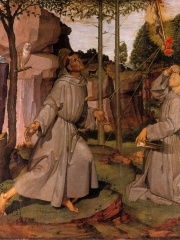
5. Francis of Assisi (1182 - 1226)
With an HPI of 87.80, Francis of Assisi is the 5th most famous Italian Religious Figure. His biography has been translated into 104 different languages.
Giovanni di Pietro di Bernardone (c. 1181–3 October 1226), known as Francis of Assisi, was an Italian mystic, poet and Catholic friar who founded the religious order of the Franciscans. Inspired to lead a Christian life of poverty, he became a beggar and an itinerant preacher. One of the most venerated figures in Christianity, Francis was canonized by Pope Gregory IX on 16 July 1228. He is commonly portrayed wearing a brown habit with a rope tied around his waist, featuring three knots symbolizing the evangelical counsels of poverty, chastity, and obedience. In 1219, Francis went to Egypt in an attempt to convert the sultan Al-Kamil and put an end to the conflict of the Fifth Crusade. In 1223, he arranged for the first live nativity scene as part of the annual Christmas celebration in Greccio. According to Christian tradition, Francis received the stigmata during the apparition of a Seraphic angel in a religious ecstasy in 1224. Francis is associated with patronage of animals and the environment. It became customary for churches to hold ceremonies blessing animals on his feast day of 4 October, which became World Animal Day. Francis was noted for his devotion to the Eucharist. Along with Catherine of Siena, Francis was designated patron saint of Italy. He is also the namesake of the city of San Francisco. 17 September is the feast of Francis' stigmatization.

6. Pope Pius XII (1876 - 1958)
With an HPI of 87.71, Pope Pius XII is the 6th most famous Italian Religious Figure. His biography has been translated into 102 different languages.
Pope Pius XII (Italian: Pio XII; born Eugenio Maria Giuseppe Giovanni Pacelli; 2 March 1876 – 9 October 1958) was head of the Catholic Church and sovereign of Vatican City from 2 March 1939 until his death on 9 October 1958. He is the most recent pope to take the pontifical name "Pius". The papacy of Pius XII was long, even by modern standards; it lasted almost 20 years, and spanned a consequential fifth of the 20th century. Pius was a diplomat pope during the destruction wrought by the Second World War, the recovery and rebuilding which followed, the beginning of the Cold War, and the early building of a new international geopolitical order, which aimed to protect human rights and maintain global peace through the establishment of international rules and institutions (such as the United Nations). Born, raised, educated, ordained, and resident for most of his life in Rome, his work in the Roman Curia—as a priest, then bishop, then cardinal—was extensive. He served as secretary of the Vatican's diplomatic Department of Extraordinary Ecclesiastical Affairs, papal nuncio to Germany, Camerlengo of the Apostolic Chamber, and Cardinal Secretary of State for the Holy See, in which capacity he worked to conclude treaties with various European and Latin American nations, including the Reichskonkordat treaty with Nazi Germany. While the Vatican was officially neutral during the Second World War, the Reichskonkordat and Pius' leadership of the Catholic Church during the war remain the subject of controversy—including allegations of public silence and inaction concerning the fate of the Jews. Pius employed diplomacy to aid the victims of the Nazis during the war and, by directing the church to provide discreet aid to Jews and others, saved thousands of lives. Pius maintained links to the German resistance, and shared intelligence with the Allies. His strong public condemnation of genocide was considered inadequate by the Allied Powers, while the Nazis viewed him as an Allied sympathizer who had dishonoured his policy of Vatican neutrality. During his papacy, the Catholic Church issued the Decree against Communism, declaring that Catholics who profess the atheistic and materialist doctrines of communism are to be excommunicated as apostates from the Christian faith. The church experienced severe persecution and mass deportations of Catholic clergy in the Eastern Bloc. He explicitly invoked ex cathedra papal infallibility with the dogma of the Assumption of Mary in his Apostolic constitution Munificentissimus Deus. His forty-one encyclicals include Mystici Corporis Christi, on the Church as the Mystical Body of Christ; Mediator Dei on liturgy reform; and Humani generis, in which he instructed theologians to adhere to episcopal teaching and allowed that the human body might have evolved from earlier forms. He removed, by additional international cardinal appointments, the Italian majority in the College of Cardinals in 1946. After he died in 1958, Pope Pius XII was succeeded by John XXIII. In the process towards sainthood, his cause for canonization was opened on 18 November 1965 by Paul VI during the final session of the Second Vatican Council. Upon the opening of his beatification process in 1990, Pius was titled a Servant of God. Benedict XVI declared Pius XII venerable on 19 December 2009.

7. Pope Pius IX (1792 - 1878)
With an HPI of 87.55, Pope Pius IX is the 7th most famous Italian Religious Figure. His biography has been translated into 95 different languages.
Pope Pius IX (Italian: Pio IX; born Giovanni Maria Battista Pietro Pellegrino Isidoro Mastai-Ferretti; 13 May 1792 – 7 February 1878) was head of the Catholic Church from 1846 to 1878. His reign of nearly 32 years is the longest verified of any pope in history and second only to Saint Peter according to Catholic tradition. He was notable for convoking the First Vatican Council in 1868 which defined the dogma of papal infallibility before taking a break in summer of 1870. The council never reconvened. At the same time, France started the Franco-Prussian War and removed the troops that protected the Papal States, which allowed the Capture of Rome by the Kingdom of Italy on 20 September 1870. Thereafter, he refused to leave Vatican City, declaring himself a "prisoner in the Vatican". At the time of his election, he was a liberal reformer, and during his early papacy, he enacted progressive reforms, but his approach changed after the Revolutions of 1848. When his prime minister, Pellegrino Rossi, was assassinated and Pius himself was made prisoner in his own palace, he fled Rome and excommunicated all participants in the short-lived Roman Republic. After its suppression by the French army and his return in 1850, his policies and doctrinal pronouncements became increasingly conservative. He was responsible for the kidnapping of Edgardo Mortara, a six-year-old taken by force from his Jewish family who went on to become a Catholic priest in his own right and unsuccessfully attempted to convert his Jewish parents. In his 1849 encyclical Ubi primum, he emphasized Mary's role in salvation. In 1854, he promulgated the dogma of the Immaculate Conception, articulating a long-held Catholic belief that Mary, the Mother of God, was conceived without original sin. His 1864 Syllabus of Errors was a strong condemnation of liberalism, modernism, moral relativism, secularization, separation of church and state, and other Enlightenment ideas. His appeal for financial support revived global donations known as Peter's Pence. He strengthened the central power of the Holy See and Roman Curia over the worldwide Catholic Church, while also formalizing the pope's ultimate doctrinal authority (the dogma of papal infallibility defined in 1870). Pope John Paul II beatified him in 2000.

8. Pope Pius XI (1857 - 1939)
With an HPI of 86.66, Pope Pius XI is the 8th most famous Italian Religious Figure. His biography has been translated into 101 different languages.
Pope Pius XI (Italian: Pio XI; born Ambrogio Damiano Achille Ratti, Italian: [amˈbrɔːdʒo daˈmjaːno aˈkille ˈratti]; 31 May 1857 – 10 February 1939) was head of the Catholic Church from 6 February 1922 until his death in February 1939. He was also the first sovereign of Vatican City upon its creation on 11 February 1929. Pius XI issued numerous encyclicals, including Quadragesimo anno on the 40th anniversary of Pope Leo XIII's groundbreaking social encyclical Rerum novarum, highlighting the capitalistic greed of international finance, the dangers of atheistic socialism/communism, and social justice issues, and Quas primas, establishing the feast of Christ the King in response to anti-clericalism. The encyclical Studiorum ducem, promulgated 29 June 1923, was written on the occasion of the 6th centenary of the canonization of Thomas Aquinas, whose thought is acclaimed as central to Catholic philosophy and theology. The encyclical also singles out the Pontifical University of Saint Thomas Aquinas, Angelicum as the preeminent institution for the teaching of Aquinas: "ante omnia Pontificium Collegium Angelicum, ubi Thomam tamquam domi suae habitare dixeris" (before all others the Pontifical Angelicum College, where Thomas can be said to dwell). The encyclical Casti connubii promulgated on 31 December 1930 prohibited Catholics from using contraception. To establish or maintain the position of the Catholic Church, Pius XI concluded a record number of concordats, including the Reichskonkordat with Nazi Germany, and he condemned their betrayals four years later in the encyclical Mit brennender Sorge ("With Burning Concern"). During his pontificate, the longstanding hostility with the Italian government over the status of the papacy and the Church in Italy was successfully resolved in the Lateran Treaty of 1929. He was unable to stop the persecution of the Church and the killing of clergy in Mexico, Spain, and the Soviet Union. He canonized saints including Thomas More, Peter Canisius, Bernadette of Lourdes, and Don Bosco. He beatified and canonized Thérèse de Lisieux, for whom he held special reverence, and gave equivalent canonization to Albertus Magnus, naming him a Doctor of the Church due to his writings' spiritual power. He took a strong interest in fostering the participation of laypeople throughout the Church, especially in the Catholic Action movement. The end of his pontificate was dominated by speaking out against Adolf Hitler and Benito Mussolini, and defending the Catholic Church from intrusions into its life and education. Pius XI died on 10 February 1939 in the Apostolic Palace and was buried in the Papal Grotto of Saint Peter's Basilica. In the course of excavating space for his tomb, two levels of burial grounds were uncovered that revealed bones now venerated as the bones of St. Peter.

9. Pope Pius X (1835 - 1914)
With an HPI of 86.02, Pope Pius X is the 9th most famous Italian Religious Figure. His biography has been translated into 96 different languages.
Pope Pius X (Italian: Pio X; born Giuseppe Melchiorre Sarto; 2 June 1835 – 20 August 1914) was head of the Catholic Church from 4 August 1903 until his death in August 1914. Pius X is known for opposing modernist interpretations of Catholic doctrine, and for promoting liturgical reforms and Thomist scholastic theology. He initiated the preparation of the 1917 Code of Canon Law, the first comprehensive and systemic work of its kind, which was ultimately promulgated by his successor. He is venerated as a saint in the Catholic Church. Born in the Austrian Empire, Pius X was devoted to the Blessed Virgin Mary under the title of Our Lady of Confidence; while his papal encyclical Ad diem illum took on a sense of renewal that was reflected in the motto of his pontificate. He advanced the Liturgical Movement by formulating the principle of participatio actuosa (active participation of the faithful) in his motu proprio, Tra le sollecitudini (1903). He encouraged the frequent reception of Holy Communion, and he lowered the age for First Communion, which would become a lasting innovation of his papacy. Like his predecessors, Pius X promoted Thomism as the principal philosophical method to be taught in Catholic institutions. He opposed various 19th-century philosophies that he viewed as an intrusion of secular errors incompatible with Catholic dogma, especially modernism, which he critiqued as the synthesis of every heresy. Pius X was known for his firm demeanour and sense of personal poverty, reflected by his membership of the Third Order of Saint Francis. He regularly gave sermons from the pulpit, a rare practice at the time. After the 1908 Messina earthquake, he filled the Apostolic Palace with refugees, long before the Italian government acted. He rejected any kind of favours for his family, and his close relatives chose to remain in poverty, living near Rome. He also undertook a reform of the Roman Curia with the Apostolic Constitution Sapienti consilio in 1908. After his death, a strong cult of devotion followed his reputation for piety and holiness. He was beatified in 1951 and canonized in 1954 by Pope Pius XII. A statue bearing his name stands within Saint Peter's Basilica, and his birth town was renamed Riese Pio X after his death.
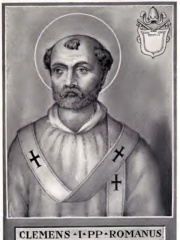
10. Pope Clement I (40 - 99)
With an HPI of 86.00, Pope Clement I is the 10th most famous Italian Religious Figure. His biography has been translated into 95 different languages.
Clement of Rome (Latin: Clemens Romanus; Ancient Greek: Κλήμης Ῥώμης, romanized: Klēmēs Rōmēs; died c. 100), also known as Pope Clement I, was the Bishop of Rome in the late first century. He is considered to be the first of the Apostolic Fathers of the Church. Little is known about Clement's life. Tertullian claimed that Clement was ordained by Saint Peter. Early church lists place him as the second or third bishop of Rome. Eusebius, in his book Church History mentioned Clement as the third bishop of Rome and as the "co-laborer" of Paul. In Against Heresies, Irenaeus described Clement as the successor to Anacletus, who was the third bishop of Rome, and as a personal acquaintance of the Apostles. According to the Annuario Pontificio, Clement was the fourth bishop of Rome, holding office at the very end of the 1st century. It is likely that Clement died in exile, and was possibly martyred. According to apocryphal stories dating back to the 4th century by authors such as Rufinus, Clement was imprisoned by Roman Emperor Trajan, and was executed by being tied to an anchor and thrown into the sea. The Liber Pontificalis states that Clement died in Greece in the third year of Trajan's reign, or 100. The only known genuine extant writing of Clement is his letter to the church at Corinth (1 Clement) in response to a dispute in which certain presbyters of the Corinthian church had been deposed. He asserted the authority of the presbyters as rulers of the church because they had been appointed by the Apostles. His letter, which is one of the oldest extant Christian documents outside the New Testament, was read in the church at Corinth, along with other epistles, some of which later became part of the Christian canon. This letter is considered to be the earliest affirmation of the principle of apostolic succession. A second epistle, 2 Clement, was once controversially attributed to Clement, although recent scholarship suggests it to be a homily by another author. In the pseudo-Clementine Writings, Clement is the intermediary through whom the apostles teach the church. Clement is recognized as a saint in many Christian churches and a patron saint of mariners. He is commemorated on 23 November in the Catholic Church, the Anglican Communion, and the Lutheran Church. In Eastern Orthodox Christianity his feast is kept on 25 November.
People
Pantheon has 569 people classified as Italian religious figures born between 70 BC and 1974. Of these 569, 65 (11.42%) of them are still alive today. The most famous living Italian religious figures include Pietro Parolin, Giovanni Battista Re, and Tarcisio Bertone. The most famous deceased Italian religious figures include Pope John Paul I, Pope Leo XIII, and Pope Paul VI. As of April 2024, 12 new Italian religious figures have been added to Pantheon including Diego Ravelli, Piero Pioppo, and Baldassare Reina.
Living Italian Religious Figures
Go to all RankingsPietro Parolin
1955 - Present
HPI: 76.84
Giovanni Battista Re
1934 - Present
HPI: 75.89
Tarcisio Bertone
1934 - Present
HPI: 74.55
Angelo Scola
1941 - Present
HPI: 70.24
Matteo Zuppi
1955 - Present
HPI: 70.05
Giovanni Angelo Becciu
1948 - Present
HPI: 69.64
Giuseppe Bertello
1942 - Present
HPI: 67.78
Raniero Cantalamessa
1934 - Present
HPI: 67.58
Carlo Maria Viganò
1941 - Present
HPI: 66.73
Beniamino Stella
1941 - Present
HPI: 65.93
Pierbattista Pizzaballa
1965 - Present
HPI: 65.85
Giovanni Lajolo
1935 - Present
HPI: 65.56
Deceased Italian Religious Figures
Go to all RankingsPope John Paul I
1912 - 1978
HPI: 89.80
Pope Leo XIII
1810 - 1903
HPI: 88.51
Pope Paul VI
1897 - 1978
HPI: 88.00
Pope John XXIII
1881 - 1963
HPI: 87.98
Francis of Assisi
1182 - 1226
HPI: 87.80
Pope Pius XII
1876 - 1958
HPI: 87.71
Pope Pius IX
1792 - 1878
HPI: 87.55
Pope Pius XI
1857 - 1939
HPI: 86.66
Pope Pius X
1835 - 1914
HPI: 86.02
Pope Clement I
40 - 99
HPI: 86.00
Pope Benedict XV
1854 - 1922
HPI: 85.96
Pope Urban VII
1521 - 1590
HPI: 85.06
Newly Added Italian Religious Figures (2025)
Go to all RankingsDiego Ravelli
1965 - Present
HPI: 58.13
Piero Pioppo
1960 - Present
HPI: 54.15
Baldassare Reina
1970 - Present
HPI: 54.13
Simona Brambilla
1965 - Present
HPI: 54.07
Fabio Baggio
1965 - Present
HPI: 53.94
Domenico Battaglia
1963 - Present
HPI: 52.96
Roberto Repole
1967 - Present
HPI: 51.16
Giovanni Cesare Pagazzi
1965 - Present
HPI: 49.95
Berel Lazar
1964 - Present
HPI: 49.86
Luigi Bianco
1960 - Present
HPI: 45.29
Lucio Nicoletto
1972 - Present
HPI: 42.44
Gian Franco Saba
1968 - Present
HPI: 40.66
Overlapping Lives
Which Religious Figures were alive at the same time? This visualization shows the lifespans of the 25 most globally memorable Religious Figures since 1700.

